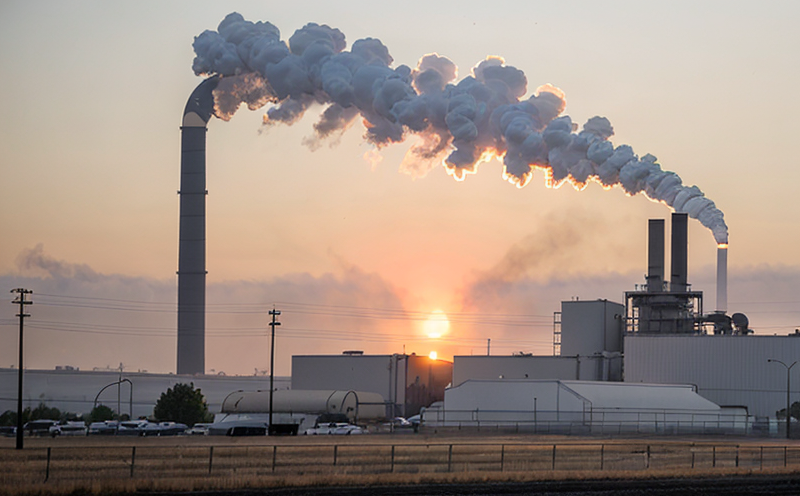ISO 15715 Carbon Monoxide Testing in Industrial Stacks
The ISO 15715 standard provides a comprehensive framework for measuring carbon monoxide (CO) emissions from industrial stacks. This service ensures that facilities meet regulatory requirements and maintain safe operating conditions, which is critical in industries such as petrochemicals, power generation, and manufacturing.
Carbon monoxide testing plays a crucial role in the safety of workers and compliance with environmental regulations. The standard outlines the procedures for sampling, analysis, and reporting CO levels in industrial stack emissions. It covers the use of gas analyzers capable of detecting low concentrations of CO and ensures accurate measurement under various atmospheric conditions.
The testing process begins with proper sample collection from the industrial stack. This involves using a suitable sampling probe to draw air samples that contain CO. The collected samples are then analyzed in our laboratory using precision instruments such as infrared gas analyzers, which provide high accuracy and reliability. Our team of experts ensures that all tests comply with ISO 15715 and other relevant international standards.
Once the analysis is complete, detailed reports are generated, providing comprehensive data on CO concentrations and their variations over time. These reports serve as valuable tools for quality managers and compliance officers to make informed decisions regarding process optimization and emission control strategies. Our service also includes recommendations for corrective actions if any deviations from acceptable limits are detected.
By adhering to ISO 15715, industrial facilities can ensure they maintain safe working environments and comply with stringent environmental regulations. This not only protects the health of employees but also helps companies avoid costly penalties associated with non-compliance. Our team of experienced professionals is dedicated to providing accurate, reliable testing services that meet the highest industry standards.
The importance of ISO 15715 cannot be overstated in today’s regulatory environment. It provides a robust methodology for quantifying CO emissions from industrial stacks, which is essential for maintaining compliance and ensuring safety. By leveraging this standard, organizations can demonstrate their commitment to environmental responsibility and worker safety.
Why It Matters
The testing of carbon monoxide (CO) emissions from industrial stacks using ISO 15715 is crucial for several reasons. Firstly, it ensures that emissions meet stringent environmental regulations, thereby protecting the environment and public health. Secondly, it helps in maintaining safe working conditions by identifying potential risks early on. Thirdly, compliance with this standard can help companies avoid costly fines and reputational damage.
Carbon monoxide is a toxic gas produced during incomplete combustion processes. In industrial settings, it can originate from various sources such as boilers, furnaces, and engines. The presence of CO in the atmosphere at high levels poses significant health risks to workers, including headaches, dizziness, and even death in severe cases. Therefore, regular monitoring and accurate measurement are vital for maintaining a safe work environment.
Environmental regulations also play a critical role in promoting sustainable practices within industries. By adhering to standards like ISO 15715, companies contribute towards reducing their carbon footprint and minimizing air pollution. This not only helps in meeting legal requirements but also enhances the company’s reputation as an environmentally responsible entity.
In summary, ISO 15715 carbon monoxide testing is essential for ensuring compliance with environmental laws, protecting worker safety, and fostering sustainable practices within industrial operations.
Scope and Methodology
The scope of ISO 15715 encompasses the measurement of CO in the exhaust gases emitted by industrial stacks. This includes various types of equipment such as boilers, furnaces, and combustion engines used in petrochemical plants, power stations, and other manufacturing facilities.
- Sampling: The sampling process involves collecting representative air samples from different locations within the stack to ensure accurate measurement of CO concentrations.
- Analytical Methods: Precision gas analyzers capable of detecting low levels of CO are used for analysis. These instruments employ infrared absorption techniques to measure CO accurately.
- Data Analysis: Collected data undergoes rigorous statistical evaluation to determine compliance with specified limits and identify trends over time.
The methodology prescribed by ISO 15715 ensures that all tests are conducted under controlled conditions, minimizing the risk of errors. This includes factors such as temperature, humidity, and pressure, which can affect CO readings.
Our laboratory adheres strictly to these guidelines, ensuring that every test performed meets the highest standards of accuracy and reliability. We provide detailed reports summarizing our findings along with recommendations for any necessary corrective actions.
Use Cases and Application Examples
- Petrochemical Plants: Ensuring compliance with emission limits set by regulatory bodies.
- Power Generation Facilities: Monitoring CO levels to maintain safe operating conditions for personnel.
- Mining Operations: Detecting leaks in ventilation systems that could lead to hazardous concentrations of CO.
- Manufacturing Industries: Optimizing combustion processes to reduce CO emissions and improve efficiency.
In addition to these specific applications, ISO 15715 carbon monoxide testing is beneficial for any industrial facility where reliable measurement of CO emissions is required. The service helps identify areas where improvements can be made in terms of process optimization and emission control.





